
Roses, roses everywhere, but ne’er a scent of fragrance.
How did it happen that roses have become more and more beautiful while all the while becoming less and less fragrant? Perhaps we have to go back to the heirloom varieties. Everywhere, roses are blooming and climbing—tea roses, floribunda roses, prickly roses such as Rosa rogusa, hybrids, and the occasional species or cultivar with the faintest of whiffs of the essence of rose. Seeing this bush of single-petalled roses in early June put me in a rosy mood.
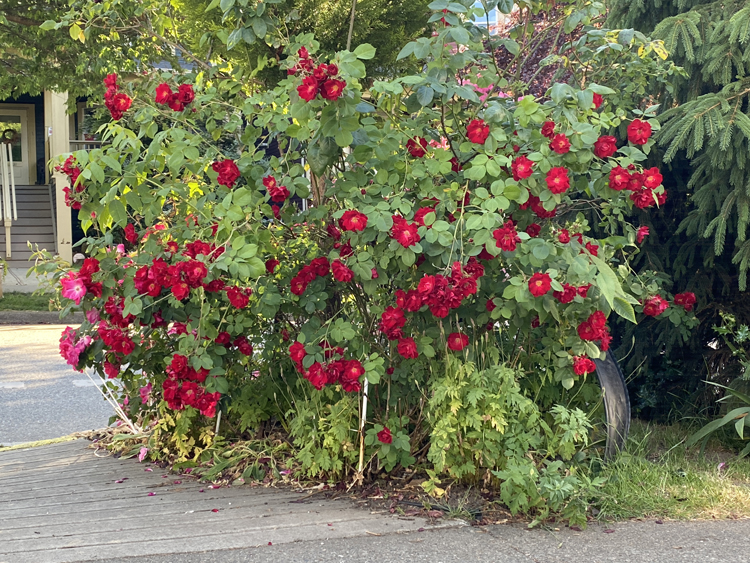
Two native and four non-native shrubs are now in bloom. In the rose family, Oceanspray, Holodiscus discolor, blooms messy panicles of botanically perfect white flowers. These attract native bees and butterflies to their pollen and the plant also hosts butterfly caterpillars.
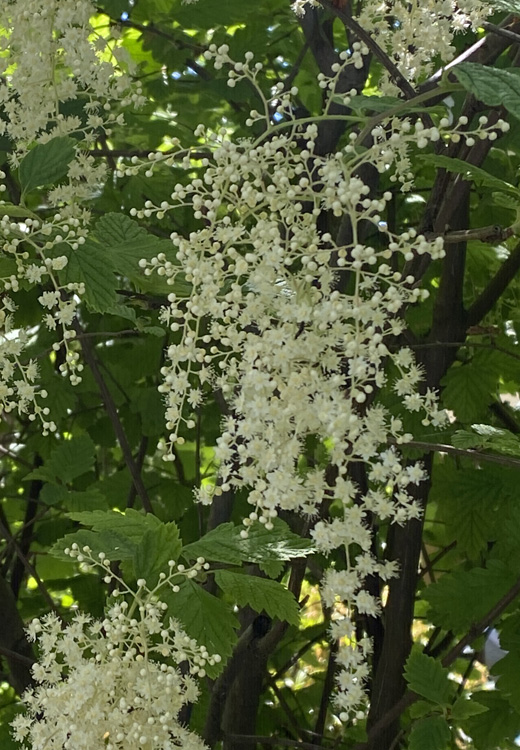
The second native shrub now in bloom is salal, Gaultheria shallon; it boasts rows of tiny bell-shaped flowers that later turn to edible purple berries. This plant is a favourite among florists for the ability of its rather stiff evergreen leaves to create the perfect backdrop in a bouquet.
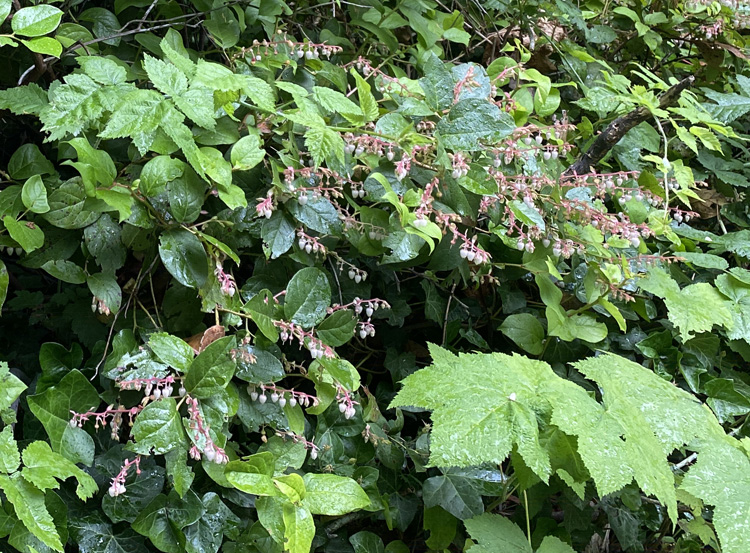
A colony-forming shrub native to eastern North America is staghorn sumac, Rhus typhina. Bees, wasps, and flies were buzzing around the large yellow panicles when I walked by. See the bees? What a transformation for these yellow inflorescences to become bobs of clusters of red drupes, which, a little at a time, can add zest and colour to meat dishes and salads.

Female smokebush shrubs, Cotinus coggygria, are now flowering, sending their threadlike floral clouds high above this year’s growth. This shrub is usually kept small through pruning, which also keeps the flowers at a reasonable height for viewing. Few male smokebush shrubs with pollen panicles are around. The males are recognizable though, even without their flowers, by their whorled leaves and the purple colour of the cultivars (most smokebush shrubs for sale are purple cultivars). Smokebush shrubs grow in a range of soil types and they are resistant to drought, a very useful feature.
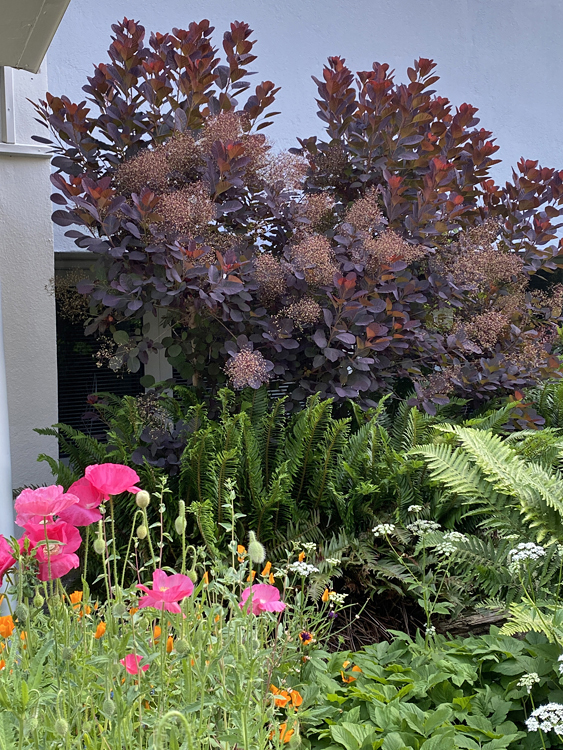
California lilac, Ceanothus spp., are in bloom and are attracting honeybees and bumblebees. As these bees hover and dart from one blue panicle to the next, the whole bush seems to be in flight. Concha is considered one of the best cultivars. This bush will now bloom for about six weeks, until the end of the summer. This plant is considered easy to grow, and it tolerates salty soils, drought, and heat.
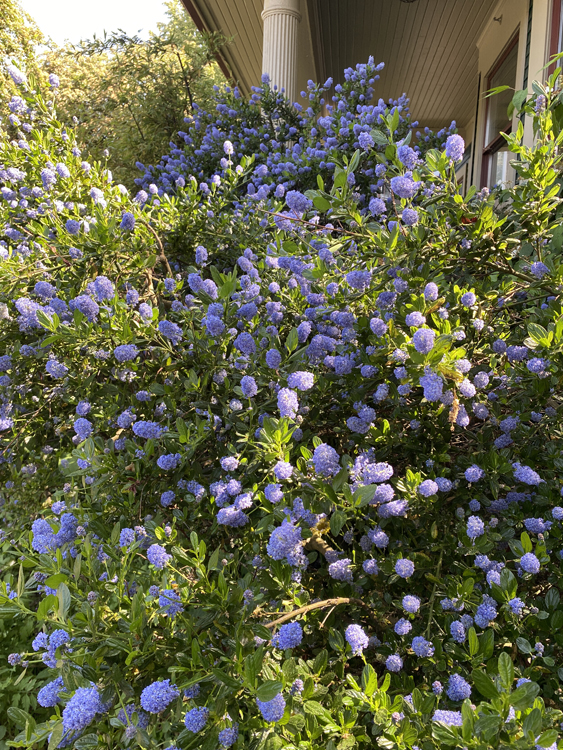
Walking with a friend around the Dr. Sun Yat-Sen Classical Chinese Garden, I admired a shrub from China—beautybush, Kolkwitzia amabilis. The multi-stemmed shrub that grows as tall as a small tree grows sweet-smelling flowers described as cymose corymbs, where cyme means one flower per stalk and corymb means the flower stalks are different lengths to allow all the blossoms to be level with each other. A member of the honeysuckle family, Caprifoliaceae, beautybush’s leaves are opposite. The flowers in the Sun Yat-Sen Garden are pale pink but the species colour moves in the direction of light purple. The plant and some of its cultivars are widely available in the Lower Mainland.
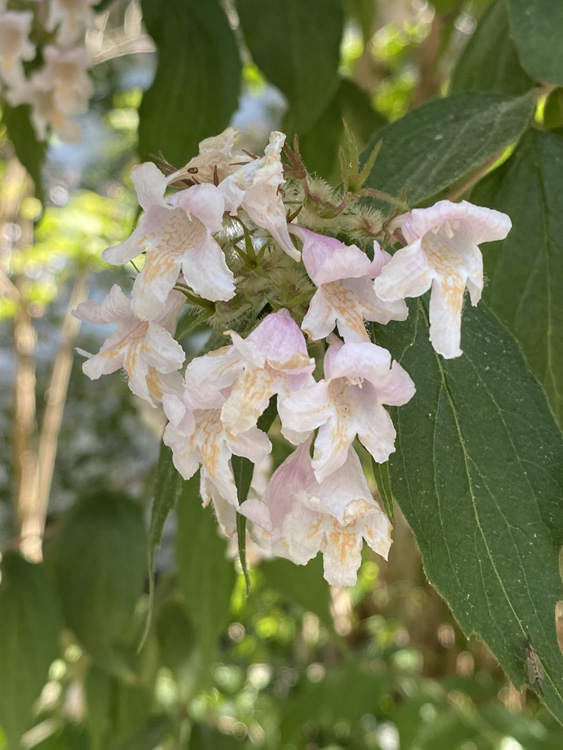
Leading a tree identification walk in Kitsilano Beach Park, the participants and I stopped to admire the alternative, pinnately compound leaves and the long chains of flowers-turning-to-fruits of a Chinese wingnut, Pterocarya stenoptera, a cousin of Caucasian wingnut, Pterocarya fraxinifolia. These trees come by their common name honestly: their method of fruiting is to grow long chains of nuts, each with its own pair of wings. The nuts are edible, sweet, and beneficial for humans.
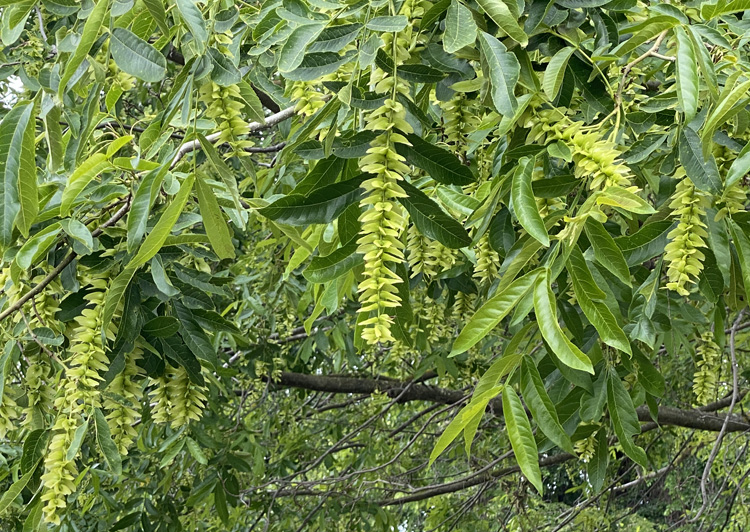
Native to Japan and Korea, Japanese stewartia, Stewartia pseudocamellia, is a small deciduous tree measuring around 8 metres after 45 years. Its flowers are similar to camellia flowers, as its scientific epithet implies, its frilly white petals surrounding an outstanding mass of orange anthers on yellow stamens. This tree has much going for it: beautiful flowers, fruit husks that often overwinter on the tree, camouflage-styled bark, and rich orange and red leaf colours in the fall. With so many interesting features, this tree species is easy to identify. 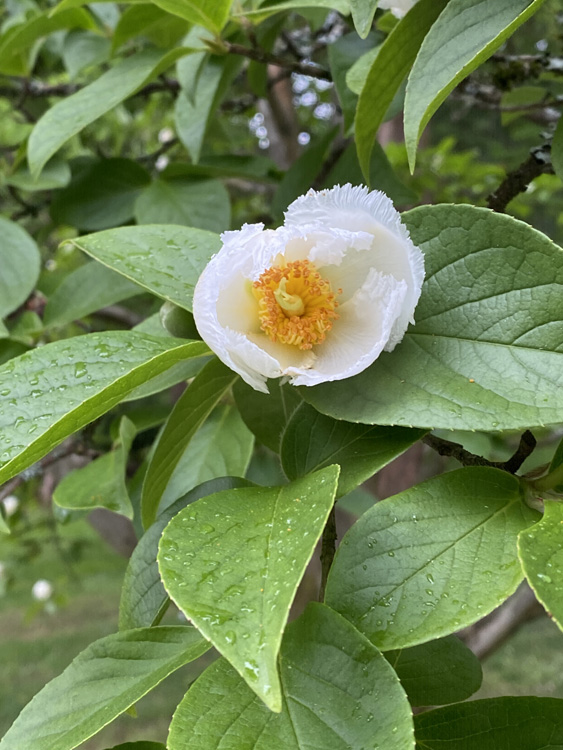
Tilia trees are in bloom, the small cream-coloured flowers in clusters of five or more, each with its own floral bract, which works, once the flower has become a fruit, as a wing to help it float a little distance from the parent tree. These are large trees (up to 15 metres after 45 years), known as lime trees in the UK, basswood in the US, and lindens in Canada. Although they are tolerant of pollution, they get a bad reputation in some parts of the Lower Mainland where park boards have planted many of the species that seem to be more susceptible to lime nail gall, which is the genus’s response to linden aphids that feed on the tree’s sap, made available through its leaves. At the worst, this infestation looks like a throng of red nails have been hammered into the upper surface of each leaf. Underneath, each aphid raises a small white bump. The result is the honeydew that makes each leaf sticky and moist, and attracts ants, which in turn protect the aphids from attack (a beneficial relationship for both). An additional result is a black sooty mould that grows in the sugar-rich honeydew. Both honeydew and mould drop on people or cars parked underneath. Very unpleasant. But gorgeous trees.
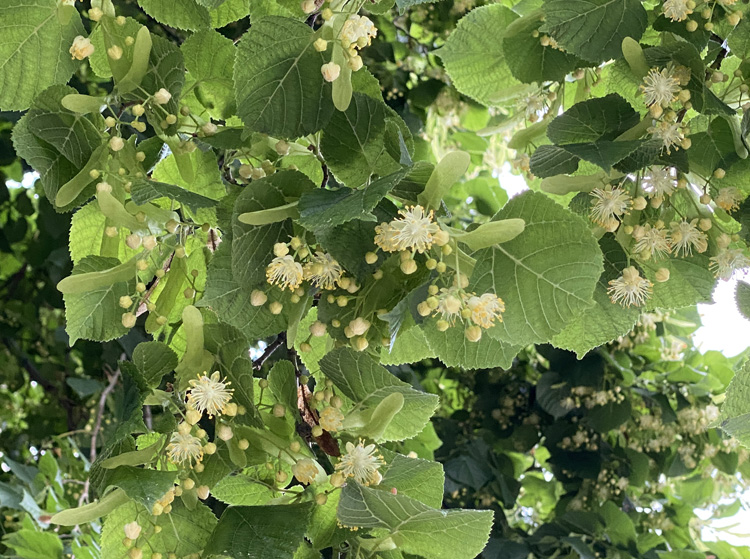
Next in bloom are the Chinese and North American species of tuliptrees, Liriodendron Chinese and L. tulipifera, both recognizable by their unique four-lobed leaves. These are large trees (up to 20 metres after 45 years) in Magnoliaceae, the magnolia family of trees that grow single large flowers. Tuliptrees grow solitary yellow flowers with six petals (like tulips). The flowers in the North American species have an orange circle surrounding the yellow petals; the Chinese species have no such orange circle. This is the species in the photo here, seen in the courtyard of the Sun Yat-Sen Garden. The leaves on tuliptrees turn a sunny yellow colour in the fall.
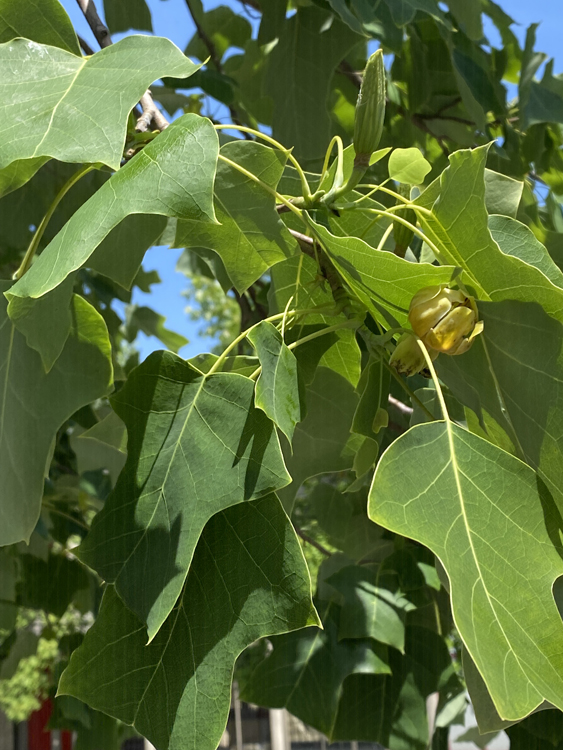
And now, just as I get ready to sign off, I notice that northern catalpa, Catalpa speciosa, is in bloom with its large upright panicles of white flowers, each with an inviting yellow nectar path for pollinators to find their way to the heart of things.
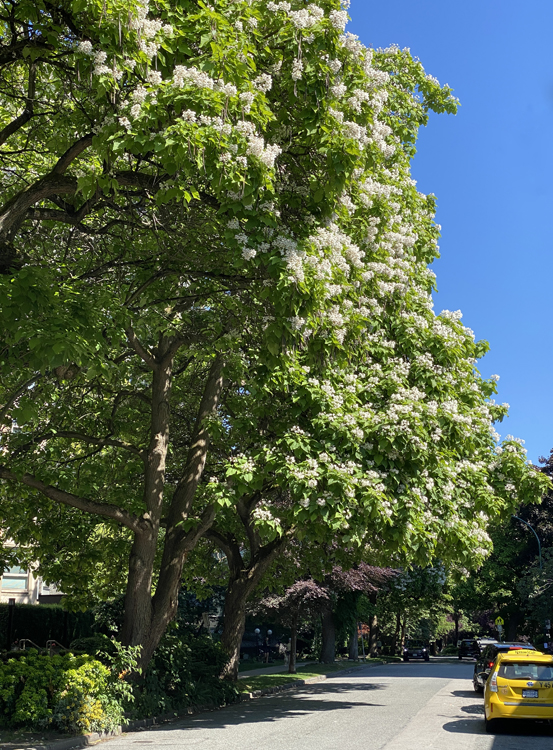
Oh look, hydrangea! I will save it for next month.
photos & text VMG Nina S.